9-simplex
| Regular decayotton (9-simplex) | |
|---|---|
 Orthogonal projection inside Petrie polygon | |
| Type | Regular 9-polytope |
| Family | simplex |
| Schläfli symbol | {3,3,3,3,3,3,3,3} |
| Coxeter-Dynkin diagram | |
| 8-faces | 10 8-simplex |
| 7-faces | 45 7-simplex |
| 6-faces | 120 6-simplex |
| 5-faces | 210 5-simplex |
| 4-faces | 252 5-cell |
| Cells | 210 tetrahedron |
| Faces | 120 triangle |
| Edges | 45 |
| Vertices | 10 |
| Vertex figure | 8-simplex |
| Petrie polygon | decagon |
| Coxeter group | A9 [3,3,3,3,3,3,3,3] |
| Dual | Self-dual |
| Properties | convex |
In geometry, a 9-simplex is a self-dual regular 9-polytope. It has 10 vertices, 45 edges, 120 triangle faces, 210 tetrahedral cells, 252 5-cell 4-faces, 210 5-simplex 5-faces, 120 6-simplex 6-faces, 45 7-simplex 7-faces, and 10 8-simplex 8-faces. Its dihedral angle is cos−1(1/9), or approximately 83.62°.
It can also be called a decayotton, or deca-9-tope, as a 10-facetted polytope in 9-dimensions.. The name decayotton is derived from deca for ten facets in Greek and -yott (variation of oct for eight), having 8-dimensional facets, and -on.
Coordinates
The Cartesian coordinates of the vertices of an origin-centered regular decayotton having edge length 2 are:
More simply, the vertices of the 9-simplex can be positioned in 10-space as permutations of (0,0,0,0,0,0,0,0,0,1). This construction is based on facets of the 10-orthoplex.
Images
| Ak Coxeter plane | A9 | A8 | A7 | A6 |
|---|---|---|---|---|
| Graph | 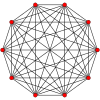
|

|

|
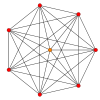
|
| Dihedral symmetry | [10] | [9] | [8] | [7] |
| Ak Coxeter plane | A5 | A4 | A3 | A2 |
| Graph | 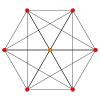
|
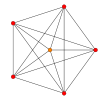
|
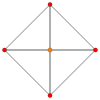
|
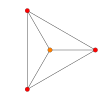
|
| Dihedral symmetry | [6] | [5] | [4] | [3] |
References
- H.S.M. Coxeter:
- Coxeter, Regular Polytopes, (3rd edition, 1973), Dover edition, ISBN 0-486-61480-8, p.296, Table I (iii): Regular Polytopes, three regular polytopes in n-dimensions (n≥5)
- H.S.M. Coxeter, Regular Polytopes, 3rd Edition, Dover New York, 1973, p.296, Table I (iii): Regular Polytopes, three regular polytopes in n-dimensions (n≥5)
- Kaleidoscopes: Selected Writings of H.S.M. Coxeter, editied by F. Arthur Sherk, Peter McMullen, Anthony C. Thompson, Asia Ivic Weiss, Wiley-Interscience Publication, 1995, ISBN 978-0-471-01003-6 [1]
- (Paper 22) H.S.M. Coxeter, Regular and Semi Regular Polytopes I, [Math. Zeit. 46 (1940) 380-407, MR 2,10]
- (Paper 23) H.S.M. Coxeter, Regular and Semi-Regular Polytopes II, [Math. Zeit. 188 (1985) 559-591]
- (Paper 24) H.S.M. Coxeter, Regular and Semi-Regular Polytopes III, [Math. Zeit. 200 (1988) 3-45]
- John H. Conway, Heidi Burgiel, Chaim Goodman-Strass, The Symmetries of Things 2008, ISBN 978-1-56881-220-5 (Chapter 26. pp. 409: Hemicubes: 1n1)
- Norman Johnson Uniform Polytopes, Manuscript (1991)
- N.W. Johnson: The Theory of Uniform Polytopes and Honeycombs, Ph.D. (1966)
- Klitzing, Richard. "9D uniform polytopes (polyyotta) x3o3o3o3o3o3o3o3o - day".
External links
- Glossary for hyperspace, George Olshevsky.
- Polytopes of Various Dimensions
- Multi-dimensional Glossary









